
|














 
|
An Itchy Rat is an Itchy Nat.Mites and lice are parasites. Rats can also sometimes carry pinworms. All of these things are pretty harmless overall but you don't want them caring for other things besides themselves. Plus, it would not be fun to be itchy all the time. I've heard things like "If your rat has scabs, he has mites...but it also may be 'too much protein'." Whatever. Little pin-prick scabs means it's mites, or lice. This is what a pin-prick scab looks like:
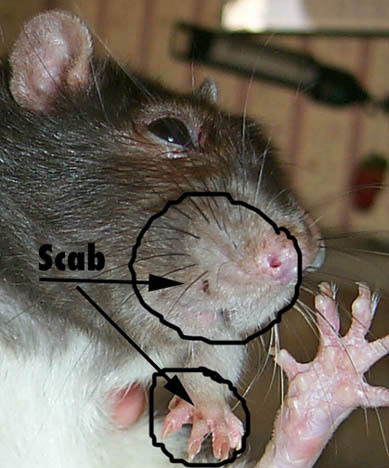 But you don't always see scabs. Fret not - there are other things you can check. I've had rats with lice that had no scabs but they did have patches of thinning fur. This could be the result of an obsessive power-groomer or maybe they're obsessive groomers themselves, but it never hurts to check....their rump. That's right! Just part some fur on their hiney and take a good, close look. A rat's rump is the meatiest and most convenient place for any bug to hang out. Most rats can't reach the area too well and, of course, there's plenty of food. So, when in doubt, check the rat's bum. There you'll find nits (louse eggs) and the lice themselves: Nits look like this (little shiny bags shellacked to the rat's strands of fur):



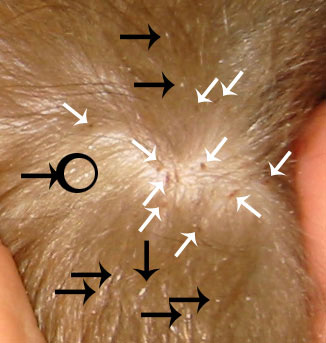  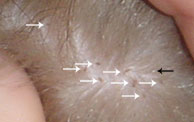 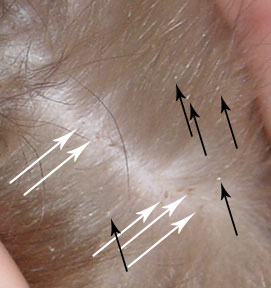 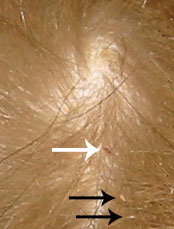 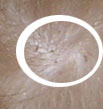 So now that you're all itchy because you found out that Templeton has lice, you'll need to do something about it for him and every rat near him (yes, that would mean "in the same house."). Easy enough. You've got two options: 1) Take Templeton and all of his ratty friends to the vet. The vet can give your rat an injection of Ivermectin (.2 mg/kg SubQ once a week for three (3) weeks) [preferred] or you can get the cat/dog flea sprays (like Frontline or Advantage) from your vet and, with a flea-spray wettened toothpick, draw a line down their backs [not preferable: If they lick their backs while it's still wet you've got problems].
2) Do-it-yourself: Head out to a Saddle shop or farm supply store and
purchase a tube of Ivermectin Horse Worming paste (1.87% Ivermectin)
that'll look something like:  Once you have your tube in hand, squirt out a little glob onto a piece of plastic (like a ziploc baggie or something). Grab a spaghetti noodle. Mix the glob thoroughly and break off the part of the noodle with white paste and throw it away. Next, grab a rat. Dip the noodle into the paste so no more than a glob the size of an UNCOOKED grain of rice is on the noodle (half for rats under 1 lb), lift a cheek (theirs, not yours) and stick the noodle in there right above their tongue. Let them keep the noodle as a reward (they love 'em). Repeat for each rat you have and dispose of the remainder of the glob on your piece of plastic (or wrap it up for next week - no need to refrigerate). In 7 days, repeat the above process. And again 7 days after that. If you look the next day after treating the lice, you should see no lice. In a week you may see some that hatched but they'll soon be gone. To compensate for the life cycle of lice and mites, treat once a week for three weeks. Make sure, during this time, that you keep their environment clean (toys, hammocks especially should be given an extra wash). Ivermectin works by paralyzing all bugs that bite your rat. If, for whatever reason, a louse is lost in the bedding or a hammock and manages to find its host later, you could conceivably (though unlikely) start the whole cycle over again so giving everything a thorough scrub, particularly during those last two weeks, is a good idea. Oh, and this applies to 99% of all parasites that may affect your rats.
Summary:
Once a week for 3 weeks to compensate for the life cycle of the bug (and his little kiddies)
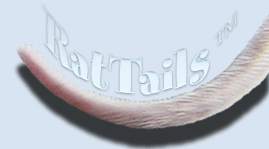 tip: When navigating through the RatTails, clicking on the image that looks like the image above will take you back to this table of contents!
Disclaimer: There are many non-sarcastic accounts and tips on the web regarding rat care. This is not
one of them. These are merely accounts of our experiences with rats, our perceptions of these experiences, where we've failed
and where we've succeeded. These accounts are here for two purposes:
|
|
